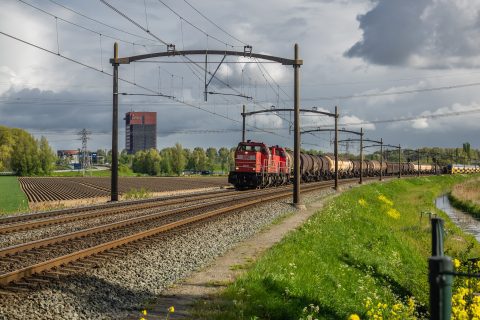Written by: RailFreight | Majorie van Leijen
Rail Cargo | 4 mins read
Labour shortage is a phenomenon that impacts industries all around the world. At DB Cargo the Netherlands, they are not sitting idle waiting for suitable candidates to come around. Instead, they are making sure that there is just less labour that can be carried out by less people. The solution? Digitalisation.
It is a fresh perspective to the digital revolution that has evolved in the rail freight industry. The industry needs to get rid of the old-fashioned, time-consuming working methods, but there is also a more immediate need for the mental shift, as there are just not enough people to carry out these works in the same old way, argues Connelie Van-Brenk, Manager Operations at the Dutch branch of DB Cargo.
Labour shortage? Digitalisation is the answer
"It is a fresh perspective to the digital revolution that has evolved in the rail freight industry."Ab Ovo
She was appointed two years ago to scrutinise the way DB Cargo operations were carried out. Operations needed to become more efficient, as there were simply not enough people to carry out the work. “I realised that if I wanted to carry out this task, we needed to digitalise some of these procedures.”
Van-Brenk turned to Ab Ovo, a digital solution provider for the rail industry. “The company looked over the shoulder during operational procedures, to see what could be done more efficiently. They came up with several solutions, such as the digital damage reports that we are now rolling out. We are now running a pilot with a handheld, rather than having to make a phone call reciting wagon numbers and other information that can easily be miscommunicated.”
Other gadgets
The handheld is only one example of a system that Ab Ovo helped to implement for DB Cargo. The operator is now also using a customer portal called Link2Rail for ordering, tracking and tracing, invoices, consignment notes, wagon status etc. It is using the wagon information message (WIM) to transmit this information, and it is using the interface Paloma.
A main advantage of Ab Ovo is that it is not just any digital solution provider, but one that is specialised in the logistics industry. Its customers are often rail companies, so it understands the challenges of the industry, and the opportunities.
Digitalising DB Cargo
“Ab Ovo looked over the shoulder during operational procedures, to see what could be done more efficiently. They came up with several solutions, such as the digital damage reports that we are now rolling out."‘Hey, this is my job’
One of these challenges is the mental shift that needs to be made, as the industry is typically old-fashioned. This mental shift does not come naturally, van-Brenck narrates. “When you tell people that their job can now be done digitally, they are reluctant to say ‘hey, this is my job’. They are used to doing this their way, but if you think about it, this digital solution is making their job easier. Rather than having to make a phone call in the rain with a written paper at hand that is getting wet, they now only need their handheld.”
With digitalisation, DB Cargo has made many processes paperless. But people are keen to look at paperwork as a classification of how much work they have, says van-Brenck. “When there is a pile of paperwork on their desk, they feel that they have a lot of work. When this paperwork is not there, they feel that they don’t have work. But this is an outdated conception. We do not need paperwork nowadays; a lot can be digitalised. Once we started omitting paperwork, our customers also realised that they do not need it, and they are now
doing things paperless too.”
Better job classification
These are examples of work that can be done more efficiently, but is this taking away the human aspect? Not directly, as van Brenk explains. It is a bit more complicated than that. “What I am trying to achieve is that the responsibilities that fall within a certain function group become more simplified. Now, due to the labour shortage, we have piled up tasks to belong to a certain function. The downside of this is that there is no clear career path for
that function.
By digitalising and thereby standardising working methods, we create space within function groups. We have already slashed the workload of the internal workforce by half. The responsibilities are now more clear. They are the ones that prepare a perfect train journey for the train driver. They manage the local terminal processes. Their job is clear, and so is their career path. We can tell these people how they can grow within their function, and therefore keep them longer.”
Just in time
This change in putting people to work has come just in time for the company. “We simply could not find the people for the job anymore. We currently have thirteen vacancies. We used to be 130 people, and we are now 120. In three to five years, we would have been way beyond the formation requirement, and we would need to cancel trains”, van Brenk explains.
“We have a structural shortage of labour, and it is not just us. We have the benefit of being a large company, with a board that finally approved our new approach. But there are also smaller companies that are less flexible.”
Nevertheless, van Brenk considers these circumstances as an opportunity, which has brought DB Cargo the Netherlands many positive developments. “The company has become less traditional. We are not there yet, but we have made some nice strides. I am proud to see that people like to stay with our company now”, she concludes, but she quickly adds: “We can always use more staff.”
Source: RailFreight.com
Official article: Labour shortage? Digitalisation is the answer, says DB Cargo | RailFreight.com



